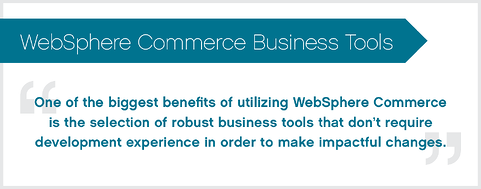
 One of the benefits of choosing WebSphere Commerce for your eCommerce site is the sheer number of applications you have at your disposal. We have talked about WebSphere Commerce Marketing Tools and, while marketing tools are important, there are so many other business functions to keep in mind when managing an eCommerce site.
One of the benefits of choosing WebSphere Commerce for your eCommerce site is the sheer number of applications you have at your disposal. We have talked about WebSphere Commerce Marketing Tools and, while marketing tools are important, there are so many other business functions to keep in mind when managing an eCommerce site.
WebSphere Commerce has a selection of robust business tools that don’t require development experience in order to make impactful changes. These tools provide you with easy-to-use catalog management capabilities that can give you a lot of control over your site. The following are just some of the powerful Business Tools offered by WebSphere Commerce.
The Catalog Tool gives you the ability to load product into WCS and manage the catalog as if WCS were a product information manager. This allows you to take your catalog data from wherever it was previously stored and organize it in WCS. The catalog is able to store a large amount of information that is leveraged in other areas of the software, including descriptive attributes, marketing information, and assets such as images, PDFs, and videos. These capabilities are crucial for eCommerce management.
The References tool gathers every location of a product into one place for easy access. It allows you to tell if a product is used in a marketing activity, is included in any bundles or cross-sells, and where its images are used, all on one screen. Therefore, if a product has been removed from the catalog or replaced with a newer model, it is easy to find and remove or replace the older product everywhere on the site.
This tool allows you to create a catalog that is completely different from your base catalog. This is helpful when you want to change your catalog for the sake of a sale when a promotional code just won’t cut it. For example, if you are hosting a blowout or end-of-season sale, you could create a completely custom catalog that is only available for a certain amount of time. Once the specified time is up, the site reverts back to the base catalog. Sales Catalogs also utilize Sales Categories.
Sales Categories are created within a sales catalog so that you can organize the Sales Catalog by SKU. As you look at the catalog entry list, you can right click on a product and generate SKUS based on the defining attributes, as well as create a SKU for each of the defining attribute combinations. The difference between defining attributes and descriptive attributes is crucial at this point:
Merchandising Associations gives you the power to display associations as an action in an eMarketing spot. These associations include things like replacements, upsells, cross-sells, and accessories. Every single items in an eCommerce store needs to have a cross- or upsell association set up in order to increase AOV and CLV. Within the Merchandising Associations tool, you can establish those relationships across the entire catalog. You also have the ability to create custom associations, or utilize predefined associations based on a customer’s shopping cart, viewing history, or current page.
Merchandising Associations can get even more specific through branching. Branching allows you to set up detailed “if/then” situations that select a product to display based on a series of conditions.
These are just some of the powerful opportunities that WebSphere Commerce Business Tools offer. The ease of use and visual setup of these functions make them extremely user-friendly, which only adds to the level of control you have over your eCommerce site.
Lorem ipsum dolor sit amet, consectetur adipiscing elit

For the past two decades, we've made it our business to help you work smarter. From commerce challenges to ERP customizations, we support the power of your big ideas by helping you work more strategically, more intuitively, and more efficiently.
2658 Scranton Road, Suite 3
Cleveland, Ohio 44113
216.369.3600
No Comments Yet
Let us know what you think